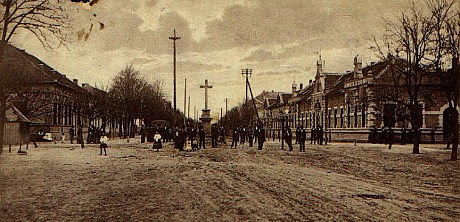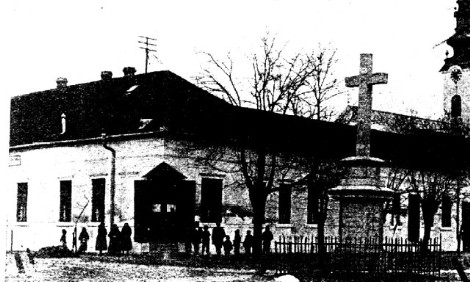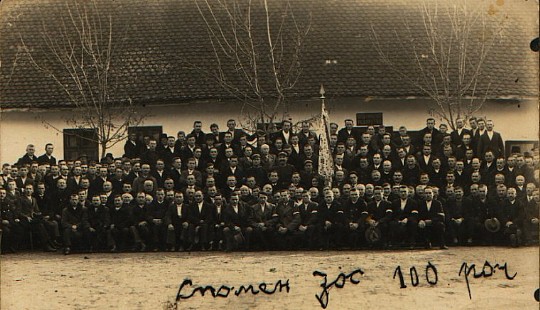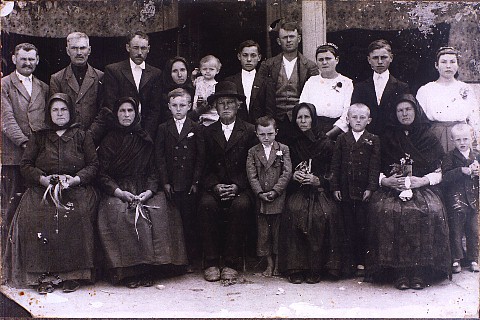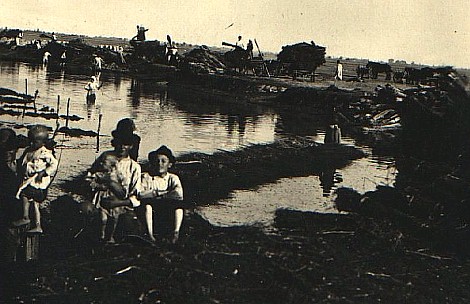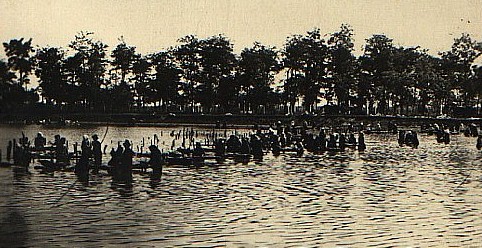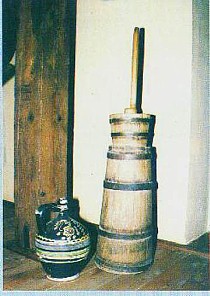A couple of items in the Homeland
museum in Ruski Kerestur
Ruski Krstur in the Kingdom of Serbs, Croats and Slovenes - Yugoslavia
(1919-1941) underwent several dramatic periods typical of all Ruthenians'
lives in these parts in general. The first one was economically difficult
because the first gap between the better-off and the poor grew wider.
The increasing number of poor and landless families resulted in an economic
emigration to Canada, USA, South America and France. The wealthier village
land-owners were still far from being rich in the capitalist sense. In
the stage of the initial accumulation of capital, the fact that they were
a minority was an obstacle because the system of privileges in money turn-over
and profit investment was not conducive to their needs; the privileges
were reserved for the capital owned by the state-building nations. The
Ruthenians of Ruski Krstur at that time, and forever after that, understood
a deeper truth or a personal historical experience which was to repeat
itself throughout the 20th century, namely: that only an economically
independent nation, individual, social class or a community can be free.
An entrepreneur or a citizen as a member of a state-building nation and
the one belonging to a minority are not in the same position as economic
subjects because it is only towards the former that the state is inclined
through its policy of economic privileges and stimuli. In addition to
the mechanism of mostly direct assimilation or systematic acculturation
which was typical of the life of the Ruthenians at Ruski Krstur in Hungary,
there appeared another economic and social mechanism supportive of the
former two - the national state protectionism. In the social life, given
this situation, the Ruthenians in Yugoslavia, Ruski Krstur, consolidated
the issue of their language, and reaffirms their national and religious
identity, realizing that, in addition to the economic independence, culture
was the most powerful preserver of one's identity; there was a growing
number of literary works written in Ruthenian and from a Ruthenian point
of view and the first national and cultural organization was founded on
August 2,1919, called the Ruthenian National Society of Education.
In 1923, Kosteljnik codified The Grammar of the Bačko-Ruthenian Speech.
Besides leaning onto the Yugoslav cultural and literary context, the Ruthenians
at Ruski Krstur had very close ties with the Ukrainian literary and cultural
life. The contribution of the Ruthenian national society of education
contributed to the development of the cultural and national identity by
1) raising the consciousness about the potential of the Ruthenians to
self-organize, i.e. to become an historical subject in this part of Europe,
2) insisting on an historical, cultural and national entity within an
overall Ukrainian cultural and national integration, 3) asserting that
the Ruthenian cultural tradition belongs to the East-Slavic cultural tradition
and needed integration in the South-Slavic cultural space, 4) claiming
that they should not turn their back to the language Ruthenians spoke
from birth, and that, although it was quite logical to receive elementary
education in that language, it would not harm intellectuals to speak Ukrainian
among other languages as well. The rightist trends at the time were not
typical of this Society only, but surfaced among other nations of Yugoslavia
as well, on the eve of World War II.
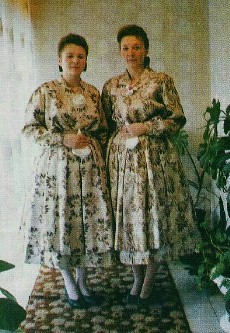
Rusyn costume from the middle
of XX cenury
After World War II, till 1991's when the Serbo-Croatian war began,
the Ruthenians of Ruski Krstur believed that their historical rights and
needs would never be disputed again and that their life would only depend
on their creative potential, common sense and their capacity to self-organize.
Most of them accepted and experienced the socialist Yugoslavia as their
own motherland. Disputes over the destiny of Yugoslavia, in the late 80's
made them fell uncertain and uneasy, because they did not have a spare
fatherland in some kind of their own republic which could go on living
as their national state, as the case would be with the state-building
nations of the Serbo-Croatian civil war, the Ruthenians of Ruski Krstur
found themselves in a dangerous sphere of suspicions, not arising from
their liability, but out of insufficient knowledge or ignorance and aversions
that other people derived from it. They found it hard to accept the possibility
that their destiny might be decided by someone who neither knows enough
nor wants to learn about the people about whom he is to decide. Publicly,
the question of equal rights of the state-building nations versus the
minorities is openly avoided. Irrespective of the doubtlessly notable
results in culture and education, which have amazed the world, the hope
of the Ruthenians of Ruski Krstur and Vojvodina as a whole grows smaller
faced with the reality of the power and logic of numbers and the laws
based on them. Their constructive and loyal attitude towards the authorities
suddenly ceases to be a guarantee for a deserved life and development.
Without the power of numbers and masses, the Ruthenians of Ruski Krstur
and Vojvodina will have to play the part of a litmus paper indicating
the validity of the current political practice and the authority of those
in power. At the same time, they have ceased to control their own destiny.
They have been reduced to being the citizens obliged to submit to the
political and public will of the state-building nations and the current
government. As a result of the influence of politics on the economy, and
without a commune with a majority of Ruthenians, but only a local community
within the commune of Kula where the arguments of their own political
will as a special ethnic community have been too weak, the Ruthenians
of Krstur have been forced to ask for what belongs to them as a collectivity.
Without economic strength, no collectivity can be free. In the 70's and
80's, the Ruthenians of Krstur had a number of achievements in culture
and education, not because before and afterwards they lacked creativity,
but because the conditions changed and creativity came to depend on the
good will of the authorities - sometimes alienated from the Ruthenians.
The agrarian reform following World War II did not fully include them
either. It is true, though, that a part of the population moved out to
Gunaroš, i.e. Novo Orahovo; over the years, they gradually blended with
the social, cultural and linguistic milieu of the more numerous and historically
more resilient nations. Even though they know how to cultivate land, they
are still knocking on the door of the government, which, much like the
one 200 years ago, did nothing of what had been expected and promised.

Funeral of Veruna
Pankovič nee Papuga (in June 1930)
Back row from left to right:
wife of Štefan Papuga Teštvir, Ilja Dudaš nee Papuga, Ana Tirkajla nee
Papuga, Marja Dudaš nee Papuga, Ana Budinski nee Dudaš, Sofija Mudri
nee Papuga, Ana Pankovič, her son Danil Pankovič.
Front row from left to
righ: Marja Džudžar nee Tirkajla, she holds in her hands his younger
brother Vladko Tirkajla, behind them there is Marja Kanjuh nee Dudaš,
Olga Makaji nee Papuga and her sister Amala Medjesi nee Papuga. On the
right is Janko Pankovič, later electrician in Ruski Kerestur (died May
2002)
Towards the end of the 80's, the Greek Catholic Church reappeared on
the historical scene, although it had lost importance among the citizens
of Ruski Krstur. Thinking and acting according to the centuries-long standards,
the Church has made it clear that in the dimensions of both the natural
and religious life it supports the unifying factors of Ruthenians and
Ukrainians and not those divide them, although it has not denied the need
to respect and cultivate the difference in their cultural and national
identities.
The last several decades have been marked by some achievements, searches
and break-downs in education and culture (theater and folk dances) and
efforts aimed at fortifying the Ruthenian national identity at Krstur.

Members of family Budinski (Brugoš, Pinter), 1972
Back row, from left to right: Miron Budinski (1929), Vladimir Budinski (1950), Julin Budinski (1932), Janko Budinski (1935), Mihajlo Budinski (1946)
Front row, from left to right:
Marija Budinski, maiden name Rac (Krenjicki), Marija Budinski, maiden name
Sopka, Natala Budinski, maiden name Birkaš, Dana Budinski, maiden name Glidžić,
Olgica Budinski (1955), Senka (Femka) Budinski (1959)
Seated, from left to right:
grandfather Jakim Budinski - Brugoš (1907), Saša Budinski (1963), and grandmother
Melana Budinski, maiden name Bodjanjec - Davidova (1910)
In the post-war period, even though education has been offered in Ruthenian,
the cultural and national identity can best be cultivated in the classes
of the Ruthenian language and literature. The history of Ruthenians has
been taught very little in general history classes as determined y the
curriculum. The Ruthenian language and literature teaching is specific
and best suited to the indirect cultivation of the national awareness.
This is why the elementary and secondary school readers and literary passages
in them have been designed for the most direct cultivation of the national
and cultural identity.
The Ruthenian national and cultural identity have been promoted
after the war and has found its expression in the spheres of culture,
education and religious life. The cultural life at Ruski Krstur gathered
together professional and amateurs around two cultural institutions: "The
Red Rosa" - a cultural festival of the Ruthenians and Ukrainians
of Yugoslavia and "The Memorial of Petar Riznič Djadja" -
a theater festival. The anthem "The Red Rose", after which
this festival was named (founded in 1961), is a composition by J. Siv?
- "Roses, Red Roses". In the 30 years of its activity, "The
Red Rose" has developed a character of its own through regular events:
art, ethnographic and historical exhibitions; "The Red Bud"
- a children's festival of music and folk dances; poetry reading and music
festival "Heart-beat"; "The Red Rose" competition
in singing and composing folk and pop music and awards presentation; "Echoes
from the Plain" - an annual festival of the Ruthenian art and culture
societies with humorous sketches; a seminar on various subjects in the
Ruthenian history and culture; "Estrada bratstva" - music and
folk dance festival of the renowned Vojvodinian and Yugoslav nations and
minorities, as guests from Ukraine and Czechoslovakia; "Keresturijada"
- a pop/rock groups competition; the greatest value of "The Red Rose"
is that it enables, at least once a year, the Ruthenians and Ukrainians
in the diaspora to meet and socialize. This is the time when the local
people put a lot of effort to host the festival; at the same time, they
build their confidence and promote their culture.
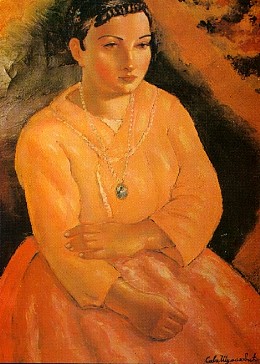
RUSYN GIRL IN PINK
Art Gallery of Sava ?umanovi?, ?id
In the course of 20 memorial festivals of Petar Riznič Djadja (the first
took place on April 6-11, 1969), the total of 207 plays were performed
(187 amateur and 20 professional). The Ruthenian amateur theater and drama
workshops staged 153 and visiting theaters 54, 170 of them for grown-ups
and 37 for children. Among the authors, there were 124 Yugoslav, 83 foreign
playwrights and 28 contemporary Ruthenians. According to the type of performances,
61 were classical, and 146 contemporary. Out of the 207, 142 were in Ruthenian,
42 Serbo-Croatian, 12 in Ukrainian. 9 in Slovakian, 1 in Rumanian and
1 in Hungarian. Out of 153 Ruthenian and Ukrainian performances entered
for the competition, 131 were directed by Ruthenian and Ukrainian directors,
and for the remaining 22, other directors were engaged. In the 20 years
of its activity, the drama festival "Petar Riznič Djadja" engaged
more than 4,000 actors and directors and about 1,000 organizers.
"Ruski Krstur - Chronicle and History (1745-1991)"
by
Dr Julijan TAMAŠ - (494 pages, printed in 1992)
